How to Promote Your Content With Social Media
By Mike Bal
Do you want that content to be seen by as many people as possible?
A master chef can present the same meal in 100 different ways, and you can do the same thing with your content.
In this article, I’ll show you the best practices of presenting the same piece of content in multiple ways on the same networks.
Facebook Link Posts
A link post is when you want to share a link in your Facebook update. Did you know that you’re able edit the headline, link description and preview image on any link post?
Think of the possibilities! I know having too many options can be overwhelming, so here’s the approach I recommend.
Step 1: Choose the image. This is the first thing people are going to notice, so make sure it does at least one of the following: catches the eye, inspires curiosity, entertains the viewer, sparks emotion or sends a compelling message.
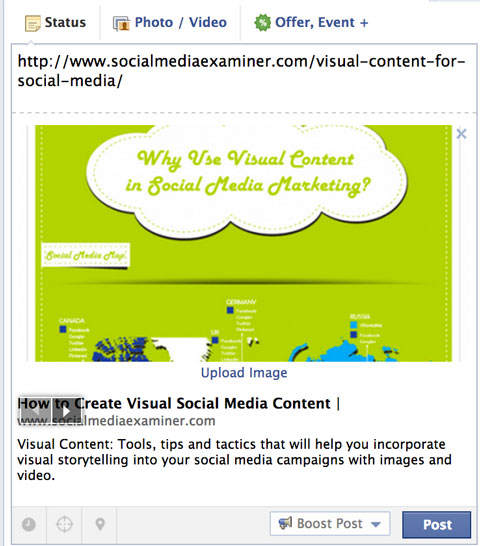
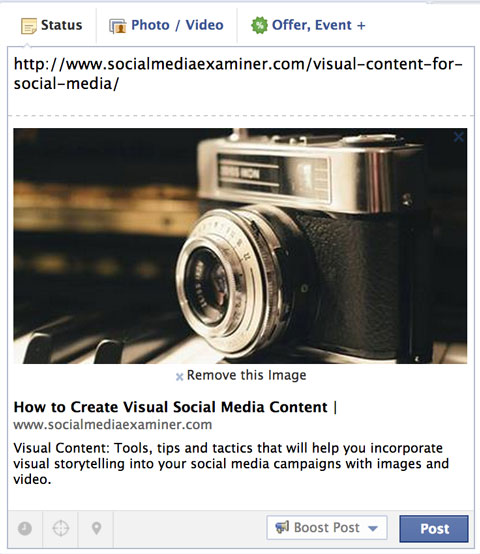 Step 2: Write the headline. There are a lot of formulas for successful headline writing out there.
Step 2: Write the headline. There are a lot of formulas for successful headline writing out there.
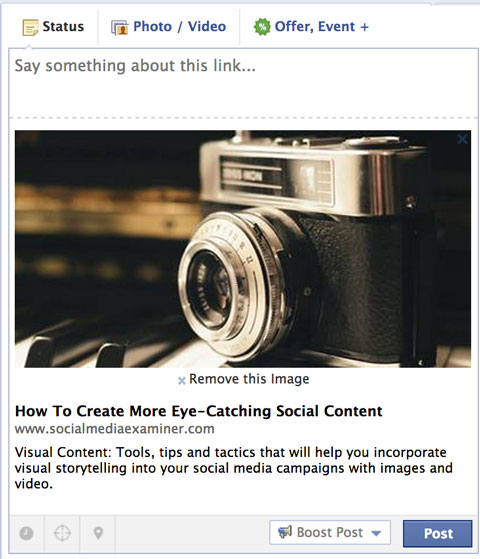 I recommend checking out Copyblogger’s How to Write Magnetic Headlines, but also use your gut and knowledge of your audience. Make references that tie your content into their other interests or play on a common scenario you know they experience; for example, “Here’s How Spock Would Handle Social Media Analysis.”
I recommend checking out Copyblogger’s How to Write Magnetic Headlines, but also use your gut and knowledge of your audience. Make references that tie your content into their other interests or play on a common scenario you know they experience; for example, “Here’s How Spock Would Handle Social Media Analysis.”
Step 3: Edit the description. The description under the headline is for all of those people who are on the fence about clicking on your link.
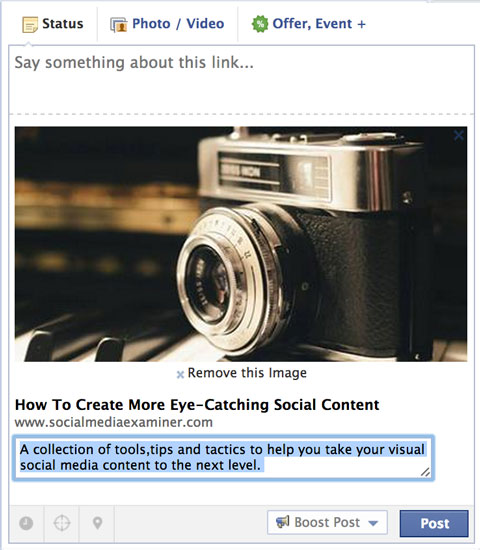 You got their attention with the image, and the headline didn’t send them running, but they still want to know exactly what they’re getting into. Give a brief and honest description of your content and the key takeaway.
You got their attention with the image, and the headline didn’t send them running, but they still want to know exactly what they’re getting into. Give a brief and honest description of your content and the key takeaway.
Facebook Image Posts
In addition to links, your Facebook post can begin with an image.
It’s no secret that images receive much more engagement on Facebook, but some people argue that links receive a higher organic reach. That’s true, but it only applies to the initial post before any engagement happens.
Often an image will start with a lower organic reach and then gain as it receives more engagement. The trick is to choose the right image and then present it with the right copy.
Still, some audiences engage just as much with the new link posts with larger image previews. The only way to know for sure is to test it on your own audience.
Before you get into the actual posting, I recommend creating a few images for your posts. Check out these great resources for creating images.
Dimensions for Facebook images are as follows:
Normal post image: 403 x 504 pixels
Highlighted post image: 843 x 403 pixels
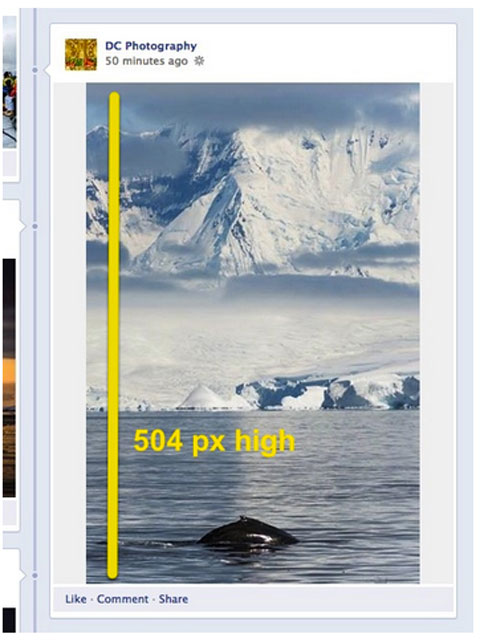 Note: If you plan to run any paid promotions for your posts, you need to make sure that no more than 20% of the image includes text. Use Facebook’s text overlay tool to be certain.
Note: If you plan to run any paid promotions for your posts, you need to make sure that no more than 20% of the image includes text. Use Facebook’s text overlay tool to be certain.
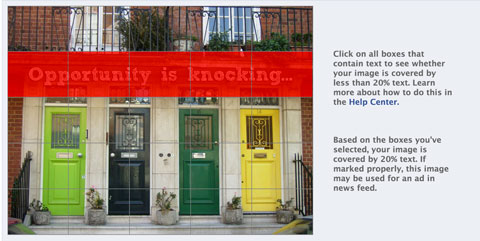 Image posts are a bit simpler than link posts, because there are fewer variables. You have your image, your post copy and your link.
Image posts are a bit simpler than link posts, because there are fewer variables. You have your image, your post copy and your link.
 I recommend you use bit.ly feelings for your links because they’re both fun and traceable, but there are plenty of options out there.
I recommend you use bit.ly feelings for your links because they’re both fun and traceable, but there are plenty of options out there.
Facebook Video/Rich Media Posts
Your third applicable option is to post a piece of rich media, like a video from YouTube or an audio clip from Soundcloud, instead of an image. This method might be useful if you included a strong piece of media within your content, or if you created something you think will convince people to click through to your content.
The biggest difference between these posts is that when they are clicked on, the media begins playing inside of Facebook. This is different from regular link posts because those take you to an outside page to view the content. And it’s different from an image post because those open Facebook’s image viewer when clicked on.
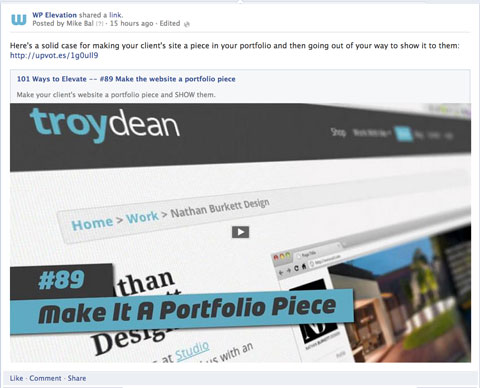 For the most part, treat video/rich media posts like you would a link post, with a couple of exceptions. You need to include a link in your post text so people can make their way back to your content, and you’ll want to highlight video posts to get the maximum amount of Timeline real estate.
For the most part, treat video/rich media posts like you would a link post, with a couple of exceptions. You need to include a link in your post text so people can make their way back to your content, and you’ll want to highlight video posts to get the maximum amount of Timeline real estate.
Ways to Promote Your Content on Facebook
Ok, let’s talk post copy. There are unlimited options, but I’m going to focus on some examples and rules that have been most successful for me.
Ask a question
When you ask a question, this doesn’t mean that you add a question mark to the headline of the article and call it good. While that works with some headlines, it’s a bad habit to get into. Think through some of the most powerful points in your content and figure out the best way to phrase the question that you’re answering for your audience. Yes, it’s like Jeopardy.
We’ll use my last SME article, How to Know if Your Social Media Activities Are Working, as an example. Ask questions from the point of view of your reader:
People connected to you, so if you let them know that this is something you worked hard on or really care about, you’re likely to get more engagement. The key is to not seem desperate or like you’re just speaking to the masses.
Here are some example templates you can use:
These tools have been around for as long as we’ve been writing things down. Use them in your social media posts to bring about a sense of familiarity and the perception of authority behind your writing.
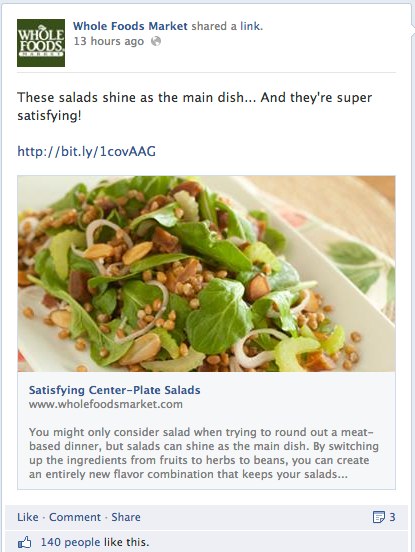 There are plenty of devices to choose from and each one may apply differently to every piece of content you create. Here are some of my favorites:
There are plenty of devices to choose from and each one may apply differently to every piece of content you create. Here are some of my favorites:
Great content should include either compelling information or compelling opinions. Those two things can be used to instantly grab your followers’ attention on social media.
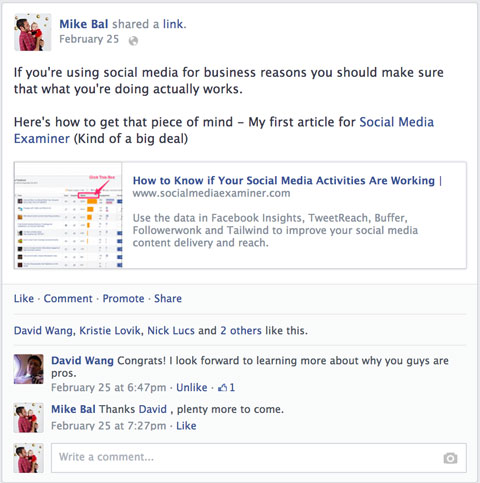 Here are a few examples of what I call power statements that you can incorporate into almost any piece of content:
Here are a few examples of what I call power statements that you can incorporate into almost any piece of content:
The first brand to engage with is the site that is publishing your content (if it’s not on your own site). In this scenario, you want to share the posts that they publish on their social profiles and @mention them in your update.
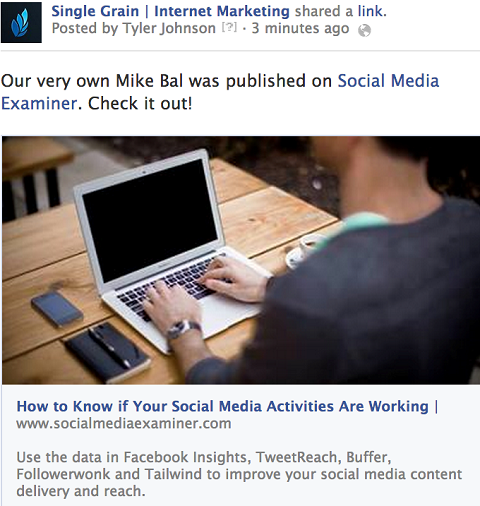 This is a good opportunity to use one of the personal status updates I mentioned above. Even if you’re sharing it on your company’s pages or profile, you can make it personal by saying something like we did in the post above.
This is a good opportunity to use one of the personal status updates I mentioned above. Even if you’re sharing it on your company’s pages or profile, you can make it personal by saying something like we did in the post above.
The next thing to think about is which brands or influencers you referenced in your content. Each one merits a different post and a direct conversation via your social channels. If you recommended the brand directly or sourced their content, there are two different things you should do to maximize their engagement.
The first is to publish posts that reference their portion of your content and mention them directly. This would be something like:
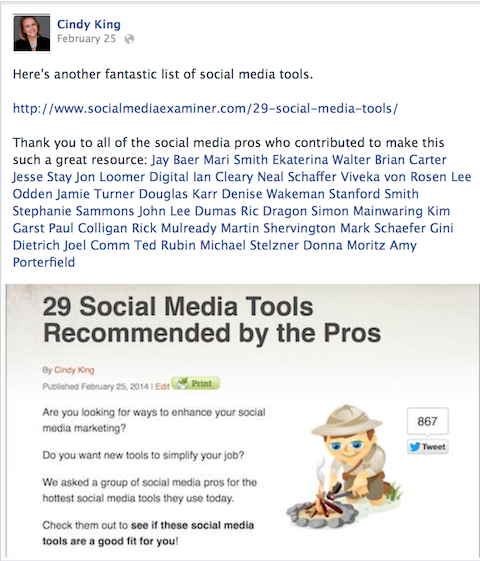 The second is a direct post to the brand (or their social media manager) to let them know that you said something nice about them. Most brands will at least reply and most of them will share the article as well.
The second is a direct post to the brand (or their social media manager) to let them know that you said something nice about them. Most brands will at least reply and most of them will share the article as well.
Post Frequency
Remember, before looking at the different ways you can promote your content on Facebook, you need to be aware of your post frequency.
Posting too often from your Facebook page can lead to a massive decrease in organic reach. This is because Facebook is ranking you based on average engagement per post, and unless you’re getting record-breaking engagement on every post, you’ll probably see a decrease in engagement if you suddenly decide to increase your posting frequency.
Most pages find a good balance around 1-3 posts a day, but always consult your Insights before setting a regular publishing schedule. At a 1-3 frequency, I’d test a schedule similar to this:
Chances are that many of your friends and family (heck, even some random acquaintances) are willing to support you, even when it comes to things they don’t understand. But don’t push your luck.
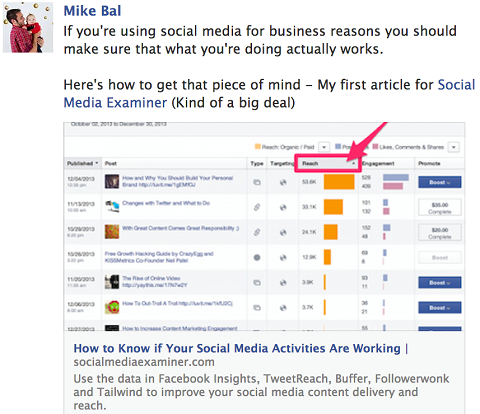 If you usually post once a day, you probably shouldn’t share your piece of content more than twice over the span of a week. If you post to Facebook multiple times a day (like me) then you can try something like this:
If you usually post once a day, you probably shouldn’t share your piece of content more than twice over the span of a week. If you post to Facebook multiple times a day (like me) then you can try something like this:
Tweets With Images
Did you know that tweets with image links get twice the engagement? Now you do, so there’s no reason not to be tweeting with images.
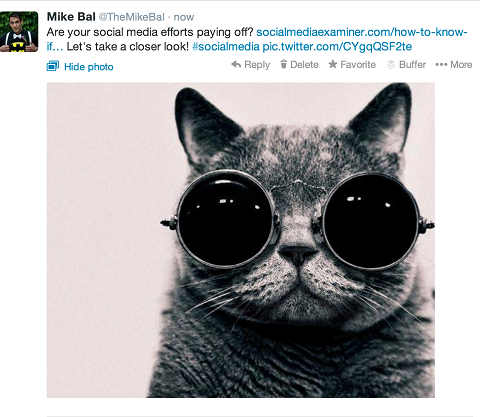 If you’re using Buffer, you can just right-click the images into your content and open them in Buffer from there.
If you’re using Buffer, you can just right-click the images into your content and open them in Buffer from there.
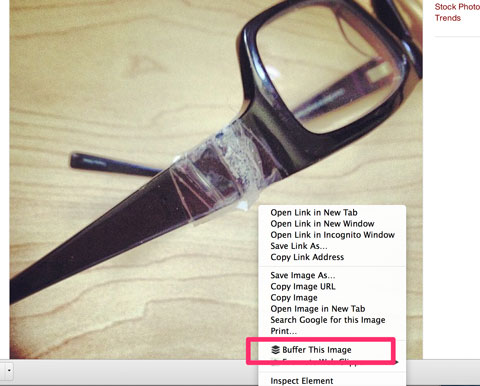 Otherwise, you can upload images with your posts in Twitter directly or from any third-party management app.
Otherwise, you can upload images with your posts in Twitter directly or from any third-party management app.
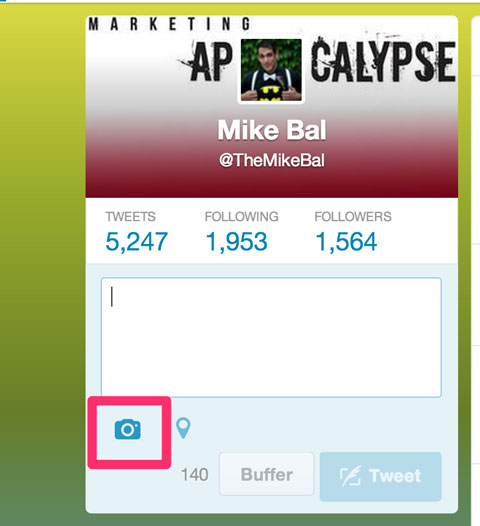 Not all of your tweets need to have images, but I’d say you should send out at least one tweet for every image you have for your content.
Not all of your tweets need to have images, but I’d say you should send out at least one tweet for every image you have for your content.
Make sure your copy is relevant to the image or provides content if the image doesn’t speak for itself.
Your image doesn’t have to be obviously related to your content. You can make a loose connection with your post copy or you can just use it to get people’s attention.
Using Hashtags
Tweets with hashtags also get twice as much engagement as those without. I use Hashtagify to find relevant and popular hashtags for any given subject.
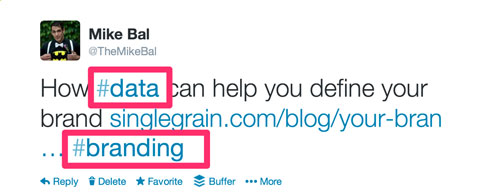 Don’t use more than two for any given tweet and don’t hashtag something if it has nothing to do with your content. Hashtags are definitely worth mentioning from a promotions standpoint.
Don’t use more than two for any given tweet and don’t hashtag something if it has nothing to do with your content. Hashtags are definitely worth mentioning from a promotions standpoint.
Retweets/Quoted Tweets
When your content starts getting shared, you’re going to see a lot of readers mentioning you directly while sharing your post.
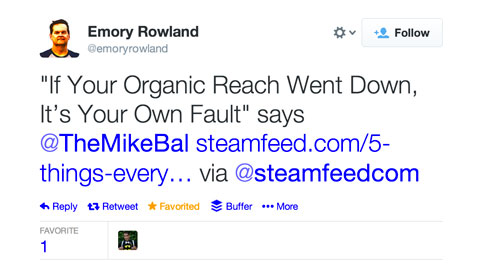 At the very least, you should thank them. In some cases, it’s appropriate to retweet them too.
At the very least, you should thank them. In some cases, it’s appropriate to retweet them too.
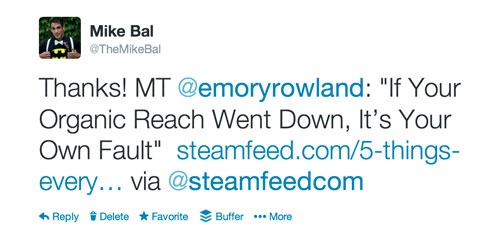 Use your best judgment and make sure you have a couple of other tweets that aren’t related to your new post going up between shares. You don’t want your profile to look like a wall of shameless self-promotion.
Use your best judgment and make sure you have a couple of other tweets that aren’t related to your new post going up between shares. You don’t want your profile to look like a wall of shameless self-promotion.
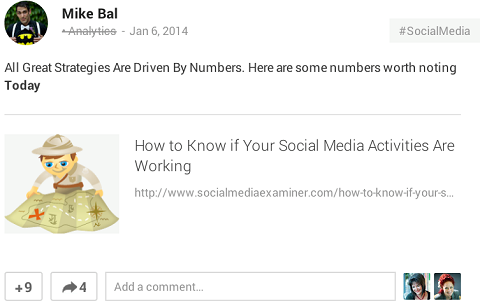 From a sharing perspective, you need to consider a few different features that are unique to the network.
From a sharing perspective, you need to consider a few different features that are unique to the network.
Circles
If you’ve been using the network to its full potential, you probably have developed several different circles.
When you share your content, you can decide which circles or users you want to share that post with. This lets you tailor the post to each different group you’ve developed.
For example, I might share something like this to a circle of social media professionals:
Communities
Google+ communities are where the party is on this network. The first thing you need to know is that you shouldn’t just drop in to share a link and then leave. Moderators usually watch pretty closely to make sure that you’re engaging with other users. So you need to put something into it if you want to get anything out of it.
The next thing to consider is that Google+ communities are divided into different discussions. Make sure you choose the appropriate discussion category. If multiple categories apply, choose the one with more active discussions.
 The final thing to know about sharing in your communities is that your copy should be a bit longer and much more conversational. Posts that give more background and have a well–thought-out discussion planned do much better. I recommend starting with an explanation of what to expect from your content and then follow that up with a request for feedback on a specific topic.
The final thing to know about sharing in your communities is that your copy should be a bit longer and much more conversational. Posts that give more background and have a well–thought-out discussion planned do much better. I recommend starting with an explanation of what to expect from your content and then follow that up with a request for feedback on a specific topic.
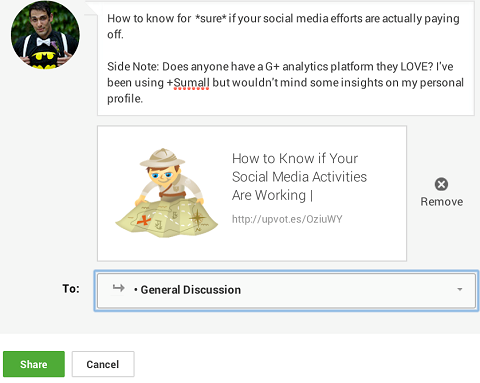 Here are a few more rules for Google+ communities:
Here are a few more rules for Google+ communities:
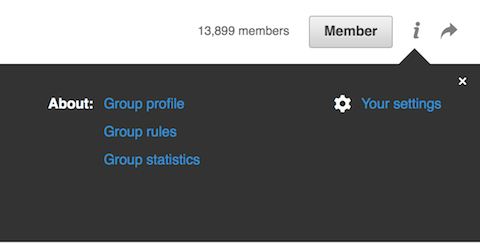 LinkedIn groups follow the same rules as Google+ communities so I’m not going to repeat that info. I will say that you should customize your headline and description to give your content context to that groupspecifically.
LinkedIn groups follow the same rules as Google+ communities so I’m not going to repeat that info. I will say that you should customize your headline and description to give your content context to that groupspecifically.
You should be pinning in two different ways.
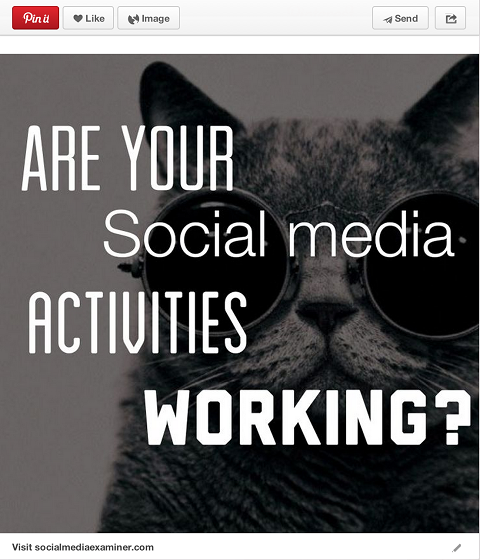 Pin from the website using the “Pin It” bookmarklet. Every image from your post should be pinned at some point. Upload the images you created as pins. Make sure that you give them solid descriptions and set the source to the original article.
Pin from the website using the “Pin It” bookmarklet. Every image from your post should be pinned at some point. Upload the images you created as pins. Make sure that you give them solid descriptions and set the source to the original article.
You now also have at least 32 different examples of post copy that you can use on all social platforms.
Facebook has 3 different post types (posts with links, image posts and video or rich media posts). Tweets can be shared with or without an image and Google+ offers the same post types as Facebook, so that’s 8 different formats to choose from.
The key to getting the most out of each network is to know how to mix and match all of the variables to reach as many people as possible, as often as possible, without coming across as redundant, intrusive or annoying to your friends and followers.
What do you think? Did you find any tactics to add to your strategy? Can you add anything to this list? What’s your social media content plan? Share your thoughts in the comments below.
A master chef can present the same meal in 100 different ways, and you can do the same thing with your content.
In this article, I’ll show you the best practices of presenting the same piece of content in multiple ways on the same networks.
#1: Feature It on Facebook
Facebook offers you three different ways to post your content: links posts, posts with images and video/rich media. Let’s dive into your options with the different post formats possible.Facebook Link Posts
A link post is when you want to share a link in your Facebook update. Did you know that you’re able edit the headline, link description and preview image on any link post?
Think of the possibilities! I know having too many options can be overwhelming, so here’s the approach I recommend.
Step 1: Choose the image. This is the first thing people are going to notice, so make sure it does at least one of the following: catches the eye, inspires curiosity, entertains the viewer, sparks emotion or sends a compelling message.

Facebook link post before uploading an image.

Facebook link post after uploading an eye-catching preview image.

Edit the headline in Facebook link posts to appeal to your audience.
Step 3: Edit the description. The description under the headline is for all of those people who are on the fence about clicking on your link.

Edit the descriptions in your Facebook link posts.
Facebook Image Posts
In addition to links, your Facebook post can begin with an image.
It’s no secret that images receive much more engagement on Facebook, but some people argue that links receive a higher organic reach. That’s true, but it only applies to the initial post before any engagement happens.
Often an image will start with a lower organic reach and then gain as it receives more engagement. The trick is to choose the right image and then present it with the right copy.
Still, some audiences engage just as much with the new link posts with larger image previews. The only way to know for sure is to test it on your own audience.
Before you get into the actual posting, I recommend creating a few images for your posts. Check out these great resources for creating images.
Dimensions for Facebook images are as follows:
Normal post image: 403 x 504 pixels
Highlighted post image: 843 x 403 pixels

Facebook images can now show at 540 pixels high.

The Text Overlay Tool lets you see if your text covers more than 20% of your image.

Bit.ly Feelings links let you share sentiment in a shortened url .
Facebook Video/Rich Media Posts
Your third applicable option is to post a piece of rich media, like a video from YouTube or an audio clip from Soundcloud, instead of an image. This method might be useful if you included a strong piece of media within your content, or if you created something you think will convince people to click through to your content.
The biggest difference between these posts is that when they are clicked on, the media begins playing inside of Facebook. This is different from regular link posts because those take you to an outside page to view the content. And it’s different from an image post because those open Facebook’s image viewer when clicked on.

Highlight your video post to showcase it in your Timeline.
Ways to Promote Your Content on Facebook
Ok, let’s talk post copy. There are unlimited options, but I’m going to focus on some examples and rules that have been most successful for me.
Ask a question
When you ask a question, this doesn’t mean that you add a question mark to the headline of the article and call it good. While that works with some headlines, it’s a bad habit to get into. Think through some of the most powerful points in your content and figure out the best way to phrase the question that you’re answering for your audience. Yes, it’s like Jeopardy.
We’ll use my last SME article, How to Know if Your Social Media Activities Are Working, as an example. Ask questions from the point of view of your reader:
- What do my most successful social media posts have in common AND what can I do with that information?
- How can I find out when my audience is online?
- Which social network is producing the best results for my business?
- What are the best analytics tools for Twitter?
- How can I get actionable data from Facebook Insights?
- What Pinterest metrics really matter?
- How can I use my data to improve my social media strategy?
- Are you backing your social media strategy with solid numbers?
- Did you know that Facebook Insights will tell you exactly when you should be posting?
- Do you know who your most engaged Twitter followers are?
- Are you reengaging your most influential Twitter connections?
- What data are you using to perfect your Pinterest strategy?
People connected to you, so if you let them know that this is something you worked hard on or really care about, you’re likely to get more engagement. The key is to not seem desperate or like you’re just speaking to the masses.
Here are some example templates you can use:
- I worked really hard on this. I’d love some feedback from all of my social-savvy friends.
- I covered a lot of ground on this post. See anything I missed?
- This is my first post for (blog) and would love to see it do well. Please take a look when you have a second; share if you think I earned it.
- I just wrote this article on social media, would love to get some feedback on my writing.
- Here’s what I learned from almost a decade of looking at social media analytics every day; thought you all might find it interesting.
- Here’s something for everyone who still has no idea what I do every day.
These tools have been around for as long as we’ve been writing things down. Use them in your social media posts to bring about a sense of familiarity and the perception of authority behind your writing.

Use alliteration to incite interest in your post.
- Alliteration
- Consonance
- Euphemisms
- Metaphors
- Onomatopoeia
- Puns
- Rhymes
- Similes
- Suspense/cliffhangers
Great content should include either compelling information or compelling opinions. Those two things can be used to instantly grab your followers’ attention on social media.

The text in this update promises compelling content.
- Most social media managers are missing out on actionable data. Are you one of them?
- Social insights can tell you how to post, when to post and what you’re doing right.
- The right data can make your social strategy infinitely more successful. Here’s how to find it.
The first brand to engage with is the site that is publishing your content (if it’s not on your own site). In this scenario, you want to share the posts that they publish on their social profiles and @mention them in your update.

If your content is being published on another site, be sure to @mention that site in your Facebook update.
The next thing to think about is which brands or influencers you referenced in your content. Each one merits a different post and a direct conversation via your social channels. If you recommended the brand directly or sourced their content, there are two different things you should do to maximize their engagement.
The first is to publish posts that reference their portion of your content and mention them directly. This would be something like:
- Did you know that @TweetReach tells you who actually helped you reach more users?
- Use @Buffer’s new business account to sort your posts by clicks or engagement type to figure out what’s working.
- @Followerwonk tells you when your followers are online AND when they’re engaged.

Remember to @mention any influencers mentioned in the content you link to.
Post Frequency
Remember, before looking at the different ways you can promote your content on Facebook, you need to be aware of your post frequency.
Posting too often from your Facebook page can lead to a massive decrease in organic reach. This is because Facebook is ranking you based on average engagement per post, and unless you’re getting record-breaking engagement on every post, you’ll probably see a decrease in engagement if you suddenly decide to increase your posting frequency.
Most pages find a good balance around 1-3 posts a day, but always consult your Insights before setting a regular publishing schedule. At a 1-3 frequency, I’d test a schedule similar to this:
- Week 1: 3-4 times
- Week 2: 2-3 times
- Week 3: 1 time
Chances are that many of your friends and family (heck, even some random acquaintances) are willing to support you, even when it comes to things they don’t understand. But don’t push your luck.

If you post several times a day, you can share your content more often on Facebook.
- Week 1: 4-5 times
- Week 2: 2-3 times
- Week 3: 1-2 times
#2: Tweet It on Twitter
Twitter is, from a functionality perspective, a much simpler social network. Because of the nature and speed of Twitter, you should post much more frequently than on Facebook or Google+. This means that you have more opportunities to share your content without annoying anyone or coming off as desperate. Since most of the post copy tips from above apply to all social updates, we’ll go ahead and jump into types of tweets.Tweets With Images
Did you know that tweets with image links get twice the engagement? Now you do, so there’s no reason not to be tweeting with images.

Tweets with images get more engagement.

Buffer lets you add an image to your tweet with a right click.

Click the camera icon to upload an image to your tweet from inside Twitter or your Twitter app.
Make sure your copy is relevant to the image or provides content if the image doesn’t speak for itself.
Your image doesn’t have to be obviously related to your content. You can make a loose connection with your post copy or you can just use it to get people’s attention.
Using Hashtags
Tweets with hashtags also get twice as much engagement as those without. I use Hashtagify to find relevant and popular hashtags for any given subject.

Shoot for a two hashtag limit in your tweets.
Retweets/Quoted Tweets
When your content starts getting shared, you’re going to see a lot of readers mentioning you directly while sharing your post.

Know when your content is being shared on Twitter.

Acknowledge those who share your content.
#3: Grab Attention on Google+
As a platform, Google+ is essentially a hybrid of Facebook and Twitter so you can reference the types of posts and features from the Facebook section above and then add hashtags.
Remember to share your content on Google+.
Circles
If you’ve been using the network to its full potential, you probably have developed several different circles.
When you share your content, you can decide which circles or users you want to share that post with. This lets you tailor the post to each different group you’ve developed.
For example, I might share something like this to a circle of social media professionals:
- Here’s how I use Facebook Insights, TweetDeck, Buffer, TweetReach and more to sharpen my social strategy: Link
- What are your favorite social analytics tools?
- Here’s my first post for +Social Media Examiner on how you can use social insights to get better results. Would love to get your feedback!
Communities
Google+ communities are where the party is on this network. The first thing you need to know is that you shouldn’t just drop in to share a link and then leave. Moderators usually watch pretty closely to make sure that you’re engaging with other users. So you need to put something into it if you want to get anything out of it.
The next thing to consider is that Google+ communities are divided into different discussions. Make sure you choose the appropriate discussion category. If multiple categories apply, choose the one with more active discussions.

Choose the most appropriate discussion category to share your content.

Share an update that also encourages discussion in your Google+ community.
- Don’t post the same content more than once.
- Respond to all comments and keep the conversation going.
- Return the favor and engage with other users’ posts.
- Make sure the community focus is relevant to your content. For example, just because I want business owners to see my content doesn’t mean that I should post in a business owner’s community. Wait to share with those communities until you have created something specifically relevant or useful to them.
#4: Lead in on LinkedIn
Any user can join up to 50 LinkedIn groups, and while the audiences may be smaller, they’re much more focused and usually more engaged. Look for relevant groups with active discussions and watch out for stale groups or non-moderated groups, as they tend to receive a lot of spam.
Click on the “i” when inside a LinkedIn group to check the group rules. Some groups do not allow you to share links to your content without context.
#5: Pin It on Pinterest
There’s a place for all of your images on Pinterest so don’t just pin them all to the same board and call it good.You should be pinning in two different ways.

Over time, use the “Pin It” bookmarklet to upload all of the images in your post to the relevant board on Pinterest.
Let’s Do the Math
Among your Facebook page, Facebook profile, Twitter account(s), Google+ profile, Google+ communities, LinkedIn groups and Pinterest profile, you have at least 7 places to post your content. You might have more if you join multiple communities or groups.You now also have at least 32 different examples of post copy that you can use on all social platforms.
Facebook has 3 different post types (posts with links, image posts and video or rich media posts). Tweets can be shared with or without an image and Google+ offers the same post types as Facebook, so that’s 8 different formats to choose from.
- 7 places to post
- 32 different options for post copy
- 8 different formats
Your Content Promotion Schedule
Day 1
Social media is a powerful tool for content distribution, but the truth is that most of us aren’t taking advantage of its full power. Each social network has unique features, options and user behaviors that affect how content is published.Day 1
- Share on Twitter with picture.
- Retweet the site that published your content.
- Share on your Facebook page with a link.
- Share from the publisher’s page on your personal profile.
- Post to your most relevant Google+ circle.
- Post to the most relevant Google+ community.
- Pin to Pinterest.
- Share to LinkedIn.
- Share with the three most relevant LinkedIn groups.
- Share the link on Twitter.
- Retweet someone else who shared it.
- Share in a different Google+ community.
- Share in 1-3 more relevant LinkedIn groups.
- Upload a unique pin on Pinterest.
- Share an image and link tweet.
- Mention an influencer or reference directly on Twitter and let them know.
- Post an image to your Google+ profile.
- Share in a different Google+ community.
- Pin another image from the post.
- Share an image post on your Facebook page.
- Share the post from your Facebook page on your personal Facebook profile.
- Mention an influencer in your tweet.
- Retweet an influencer or reader with a comment.
- Share in a Google+ community.
- Share in (3-5) remaining relevant LinkedIn groups.
- Upload custom image pins on Pinterest.
- Send out a tweet with an image.
- Send out a regular tweet.
- Mention remaining influencers on Twitter.
- Mention influencers who are active on Google+.
- Send a message to nonresponsive influencers’ Facebook page.
- Share on LinkedIn as an update.
- Send out a tweet.
- Share with other relevant Google+ circles.
- Share with remaining relevant Google+ communities.
- Send out a tweet with an image.
- Mention remaining influencers or brands on Twitter.
- Post to LinkedIn profile.
- Post to Google+ profile.
- Send an email to anyone you know who would be interested and who hasn’t already engaged via social.
The key to getting the most out of each network is to know how to mix and match all of the variables to reach as many people as possible, as often as possible, without coming across as redundant, intrusive or annoying to your friends and followers.
What do you think? Did you find any tactics to add to your strategy? Can you add anything to this list? What’s your social media content plan? Share your thoughts in the comments below.
Comments
Post a Comment